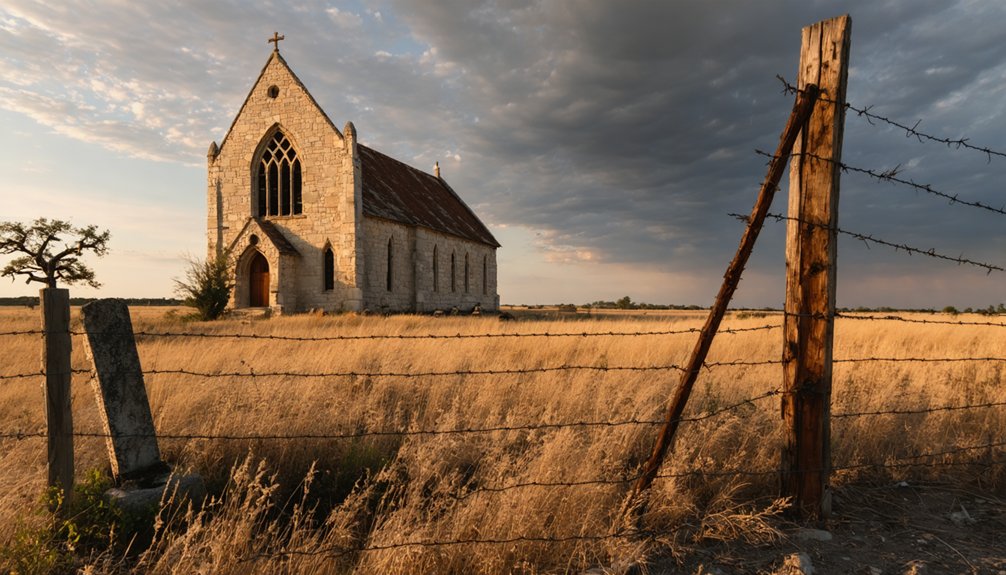You’ll find the ghost town of Hilda in Mason County’s Texas Hill Country, established by German settlers in the mid-1850s. Named after Rev. Gustave Schulze’s daughter, this former farming community features the historic Bethel Methodist Episcopal Church and Brandenberger Ranch House, showcasing remarkable stone craftsmanship. Though the town declined due to economic challenges and the Great Depression, Hilda’s preserved structures and rich German heritage offer fascinating glimpses into Texas frontier life.
Key Takeaways
- Hilda, Texas began as a German settlement in the mid-1850s near Beaver Creek and was named after Rev. Gustave Schulze’s daughter.
- The town’s main landmarks include the Brandenberger Ranch House and Bethel Methodist Episcopal Church, which served as the county’s first school.
- Economic decline occurred due to lack of railroads, depleted farmland, and increased market competition, leading to population loss.
- The Great Depression accelerated Hilda’s abandonment, causing the closure of essential institutions and erosion of community cohesion.
- The 1862 church building remains as a Recorded Texas Historic Landmark, designated in 1965, preserving part of Hilda’s heritage.
The German Roots of Hilda’s Early Settlement
As German immigrants sought refuge from overcrowding in established communities like New Braunfels and Fredericksburg, they began settling the area of Hilda, Texas in the mid-1850s.
You’ll find their arrival was part of broader immigration waves that brought 40,000 Germans to Texas between 1865 and 1900, making them the largest European immigrant group at the time. These settlers were fleeing political and religious oppression in their homeland, drawn by the promise of freedom in the Texas Hill Country.
Like many who settled along the German Belt region, the Hilda colonists created communities stretching from Galveston to the Hill Country.
John O. Meusebach had paved the way for their settlement by negotiating peace with Comanche Chiefs in 1847.
The newcomers brought rich cultural traditions that shaped Hilda’s identity, including their beloved concept of Gemütlichkeit – the spirit of warmth and hospitality.
They established churches that served as both religious and social centers, while maintaining their German language and customs through music, dance halls, and shooting clubs.
Life Along Beaver Creek: Geography and Natural Setting
You’ll find Beaver Creek flowing through southeastern Mason County about 3.5 miles east of Hilda’s church and cemetery, where it shapes the rolling terrain of mesquite, live oak, and towering pecan trees.
The creek’s reliable water supply and rich soils drew early settlers to establish farms and ranches along its banks, taking advantage of the fertile bottomlands and gently sloping hills. The surrounding landscape features steep to moderately sloping terrain that characterizes the region’s distinct topography. Fed by numerous artesian springs, the creek provides a dependable water source throughout the year.
Throughout the seasons, this essential waterway continues to define the Texas Hill Country landscape around Hilda, supporting diverse plant life and maintaining the ranching heritage that characterizes the area.
Natural Features and Terrain
The rugged terrain of Hilda rises approximately 1,500 feet above sea level, nestled within Texas Hill Country’s distinctive limestone bedrock region.
You’ll find gentle slopes and rocky outcrops defining the natural landscape, while scattered oak and cedar woodlands dot the calcareous soil.
Along Beaver Creek, you’ll discover a more vibrant ecological diversity, where springs and seeps nourish small streams and support lush riparian zones.
Similar to the nearby water source that sustained Shafter’s trees and vegetation, the area’s karst topography features hidden caves and sinkholes, influencing the movement of precious groundwater through limestone formations.
These natural features attracted early mining operations, as the limestone formations often contained valuable mineral deposits.
You’ll notice drought-resistant vegetation thriving in the semi-arid climate, where native grasses blanket open areas and protect the slopes from erosion.
The Edwards Plateau’s mineral-rich bedrock has shaped both the terrain and the region’s mining history.
Creek’s Role in Settlement
Flowing through the heart of early Hilda, Beaver Creek played a pivotal role in shaping settlement patterns and sustaining pioneer life.
You’ll find that early settlers strategically positioned their homesteads along the creek’s banks, ensuring reliable access to freshwater for drinking, cooking, and farming needs. The creek’s presence influenced where you’d have found the community’s essential structures, including the Methodist Church that served as both a spiritual center and schoolhouse. Even during the harshest droughts, the continuous flow from Deer Creek’s natural springs maintained the water supply. Similar to German immigrant settlements elsewhere in Mason County, the community developed strong agricultural roots.
The waterway fostered community cohesion through its practical benefits, serving as both a natural corridor for transportation and a gathering place for social events.
You’ll understand how the creek’s seasonal flows demanded adaptive water management, while its fertile adjacent lands supported the ranching and farming activities that became the backbone of Hilda’s early economy.
Hill Country Ranch Landscape
Nestled within the Edwards Plateau‘s vast 31,000-square-mile expanse, Hilda’s landscape embodied classic Texas Hill Country features with its rolling grasslands, stony hills, and distinctive karst topography.
Similar to other waterways in the region that begin at elevation of 1,490 feet, the streams and creeks provide essential water flow through the terrain.
You’ll find the terrain marked by limestone outcroppings, granite boulders, and natural caverns that define the ranch landscape’s rugged character.
The Hill Country’s thin, coarse-textured soils support hardy vegetation like cedar, live oak, and yucca, though the area once boasted more extensive grasslands.
The Edwards Aquifer flows beneath, while springs feed Beaver Creek and other essential water sources.
You’re in an environment where the semi-arid climate shapes everything – from the patchy vegetation cover on rocky slopes to the periodic droughts that challenge ranching operations.
This challenging yet freedom-inspiring terrain creates unique microhabitats for endemic wildlife species.
Located just west of Interstate 35, the region’s distinctive geological features have drawn visitors for generations.
Architecture and Stone Buildings of the Past
Standing as proof of early Texas frontier ingenuity, Hilda’s stone buildings showcase the architectural heritage of 19th and early 20th-century Hill Country settlements.
You’ll find remarkable stone craftsmanship in structures like the Brandenberger Ranch House, where thick limestone walls demonstrate the settlers’ practical approach to construction. The architectural durability of these buildings stems from locally sourced materials and time-tested building techniques.
The town’s churches, including the 1865 Methodist structure that doubled as a school, reflect the community’s commitment to lasting infrastructure.
You can still see how builders used hand-cut stones and simple yet effective designs to create buildings that would endure the Texas weather.
While many structures now stand in varying states of preservation, they’re evidence of the resilience of Hill Country’s German-Texan building traditions.
The Story Behind Hilda’s Unique Name
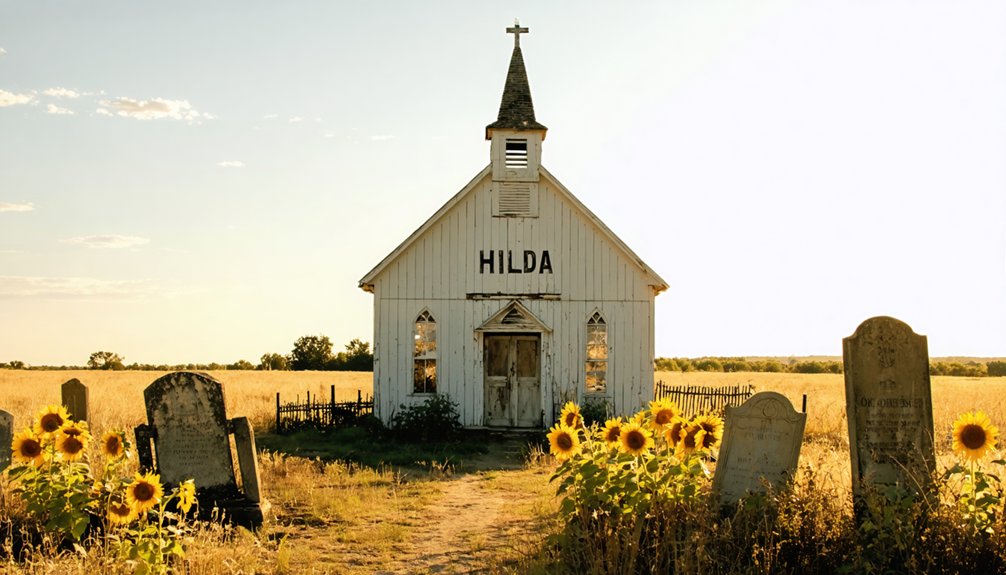
You’ll find Hilda’s name has personal roots tracing back to Hilde Schulze, a relative of the early postmistress who influenced the town’s official designation during its post office application.
This German heritage connection reflects the town’s immigrant foundations, as many settlers in the Fisher-Miller Land Grant territory brought their cultural naming traditions to Texas.
The shift from its original name “Beaver Creek” to “Hilda” exemplifies how post office establishments often prompted Texas communities to adopt more personal, family-influenced names rather than geographic descriptors.
Hilde Schulze’s Family Connection
The story behind Hilda, Texas begins with the influential Schulze family, particularly Rev. Gustave Schulze, a patriarch who shaped the town’s early development alongside his wife Emma Minna.
At 51, he fathered Nora Dorothea Schulze in 1909, establishing a lasting Schulze Legacy that would define the community’s character.
The Family Heritage of the Schulzes runs deep in Hilda’s history:
- Rev. Gustave’s daughter Hilda became the town’s namesake, cementing their family’s prominence
- The family expanded through multiple generations, with records showing between 7-12 siblings
- Notable family members included Elizabeth Agnes Baltes and Helen Corrine Frantz
- The Schulze name lives on through the Hilda Methodist Cemetery, where many family members rest
German Heritage Behind Names
Deep within the Germanic roots of Texas Hill Country lies a name rich in ancient meaning – Hilda, derived from Old High German hild meaning “battle” or “warfare.”
As a demonstration of the area’s strong German heritage, this name carries significant historical weight through its Proto-Germanic origins of *hildiz*, traditionally associated with themes of combat and valor.
You’ll find Hilda’s meaning deeply woven into Germanic mythology, where it’s connected to the legendary Valkyrie Brunhilda and the Norse figure Hildr.
When German settlers arrived in Mason County during the mid-19th century, they brought this powerful naming tradition with them.
The name’s evolution reflects both its warrior origins and its later religious significance through Saint Hilda of Whitby, who helped transform the name’s cultural impact from battlefield prowess to spiritual leadership.
Post Office Naming Story
Hidden behind Hilda’s modern identity lies a fascinating postal naming story that transformed this Texas Hill Country community from Beaver Creek to its present designation.
During the critical postal naming process, the postmistress’s connection to Hilde Schulze influenced the community’s new identity, following common practices of the era where personal relationships shaped local post office names.
- Postal officials required unique names to prevent delivery confusion within states
- The postmistress proposed “Hilda” during the official application process
- Family connections often inspired post office naming in rural Texas communities
- The name change from Beaver Creek helped establish the settlement’s distinct identity
The selection of Hilda exemplifies how postal naming practices in rural Texas communities often reflected personal ties rather than geographic features, permanently marking the area’s transformation from settlement to established community.
Ranching Heritage and Agricultural Legacy
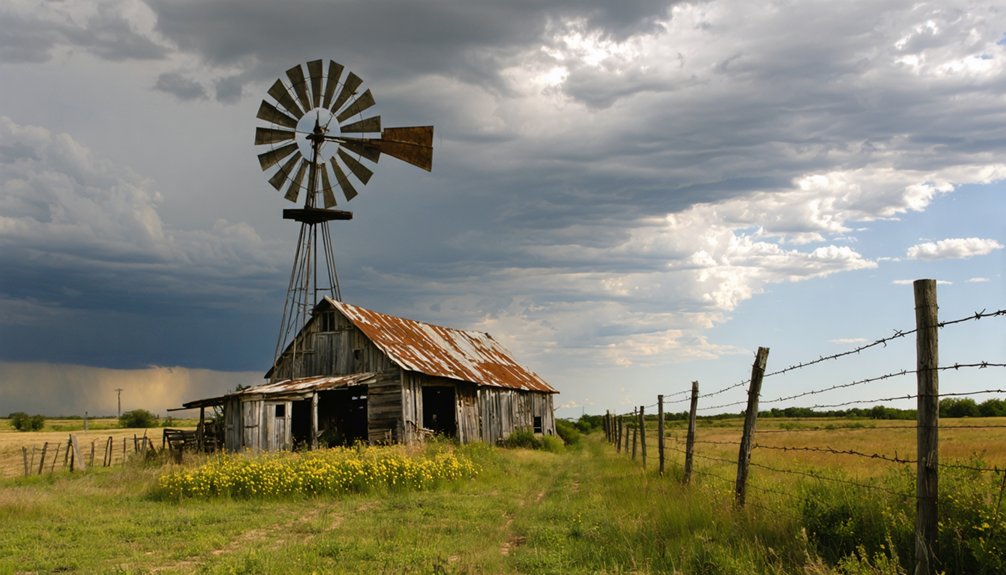
Ranching roots in Hilda trace back to the mid-1850s when German immigrants, including Wilhelm Geistweidt, established resilient agricultural operations near Beaver Creek in southeastern Mason County.
These pioneers integrated European ranching knowledge with Texas and Spanish techniques, focusing on livestock management practices suited for the arid environment.
You’ll find that ranching practices centered on hardy breeds like Texas Longhorns and later Brangus cattle, utilizing open range grazing systems typical of West-Central Texas.
While beef cattle formed the economic backbone, settlers diversified with small-scale farming to sustain their families.
The Geistweidt Ranch exemplifies this heritage, maintaining over 150 years of continuous agricultural production – a reflection of the enduring spirit of Hilda’s founding ranchers who adapted and thrived despite frontier challenges.
Notable Landmarks and Historical Markers
You’ll find the historic Brandenberger Ranch House standing as a symbol of Hilda’s ranching heritage, with its distinctive stone architecture representing early settler life in Mason County.
The Bethel Methodist Episcopal Church, complete with its preserved esshaus, serves as one of the few remaining structures from the town’s active period.
These landmarks, along with their accompanying historical markers, provide essential insights into the agricultural and religious foundations that shaped Hilda’s community.
Brandenberger Ranch History
Among the most significant historical sites in Mason County, the Brandenberger Ranch stands as a tribute to Texas Hill Country’s pioneering spirit.
The Brandenberger legacy began in 1856 when Swiss immigrant Gottlieb Brandenberger purchased 320 acres near Hilda, eventually expanding to over 10,000 acres. You’ll find a rich ranching evolution spanning generations of family stewardship.
- The historic stone ranch house remains a monument to traditional Hill Country architecture
- Gottlieb supported Confederate efforts during the Civil War, hauling cotton and supplies
- The ranch donated land for Hilda’s church and school in 1865
- Today’s Panther Creek Ranch includes 355 acres from the original 1882 holdings
The ranch’s century-plus history has earned recognition through Texas’ Family Land Heritage Program, preserving its pioneering legacy for future generations.
Church and Cemetery Legacy
Standing as proof of Mason County‘s pioneer spirit, the Hilda Methodist Church and its adjacent cemetery represent essential landmarks in Texas Hill Country’s religious heritage. Built in 1862, it’s the second church ever constructed in Mason County and holds historical significance as the site of the county’s first school.
You’ll find the church about 800 feet northwest of the Brandenberger Ranch Cemetery, while the Methodist cemetery sits half a mile east off Route 783. The cemetery’s distinctive features include wrought iron fencing around prominent graves, chronicling the lives of pioneer families who shaped the area’s community heritage.
These preserved landmarks offer valuable insights into early settler life, serving as enduring symbols of Hilda’s evolution from a vibrant settlement to a historically rich ghost town.
Daily Life in 19th Century Hilda
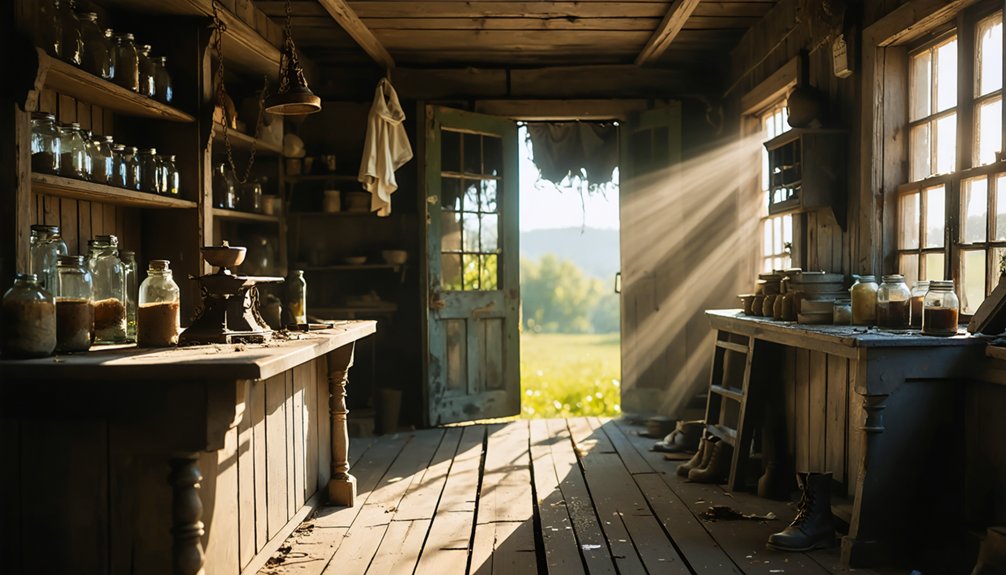
Life in 19th century Hilda revolved around a tight-knit German immigrant community that arrived around 1855, with daily routines shaped by agricultural practices and strong religious ties.
German settlers transformed Hilda into a close community bound by farming traditions and faith after arriving in 1855.
You’d find community gatherings centered around the Bethel Methodist Episcopal Church, which served as both a spiritual anchor and social hub.
Daily life included:
- Working the land to grow corn, wheat, and vegetables while raising cattle and goats
- Participating in cooperative farming tasks and bartering goods with neighbors
- Attending one-room schoolhouses where children learned basic subjects
- Joining weekly church activities, barn dances, and fundraisers that strengthened community bonds
Travel was limited to horse and wagon on unpaved roads, while communication relied heavily on face-to-face interactions during social events.
Women played crucial roles in both farm work and household management, contributing greatly to the community’s survival.
The Path to Becoming a Ghost Town
While Hilda once flourished as a vibrant German settlement, its transformation into a ghost town unfolded through a complex web of economic and social factors during the early-to-mid 20th century.
You’ll find that Hilda’s decline stemmed from its lack of economic sustainability, as the community struggled without railroads or major highways to support trade. The depletion of farmland and increased market competition drove younger generations to seek opportunities elsewhere, while the Great Depression accelerated the exodus of families.
You can trace the erosion of community cohesion through the closure of essential institutions – the Methodist church, school, and post office. The town’s isolation, coupled with unfavorable geography and limited resources, ultimately sealed its fate in the shifting tides of 20th century industrialization.
Preserving Hilda’s Historical Memory
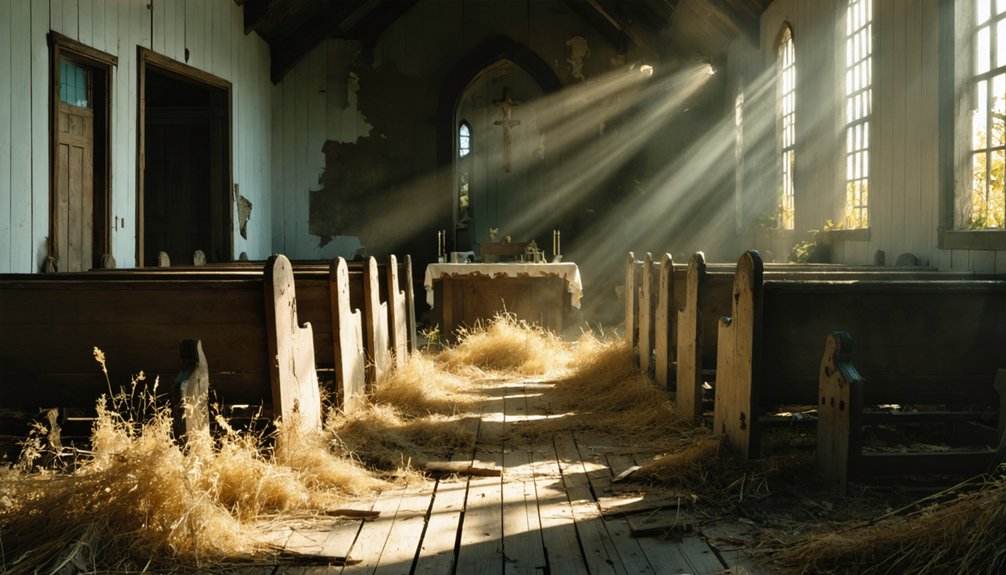
Despite Hilda’s physical decline, dedicated efforts to preserve its historical legacy continue through multiple channels.
You’ll find extensive historical documentation through the Texas State Historical Association and local historical societies, ensuring the town’s story lives on for future generations.
Community involvement in preserving Hilda’s memory takes many forms:
- The 1862 church building, designated as a Recorded Texas Historic Landmark in 1965, stands as a symbol of preservation efforts
- Digital archives and online platforms make historical records accessible worldwide
- Local historical societies maintain collections of photographs and oral histories
- Community events and heritage festivals keep the town’s cultural legacy alive
Through these preservation initiatives, you can explore Hilda’s rich history through both physical landmarks and carefully curated historical records.
Hidden Gems of the Texas Hill Country
Throughout Texas Hill Country, you’ll discover a constellation of fascinating ghost towns that tell the story of the region’s frontier past. Hidden treasures like Bankersmith and Luckenbach showcase preserved dance halls and railroad tunnels, while towns like Friendship lie mysteriously beneath lake waters.
You’ll find cultural significance in every corner, from historic churches and schools to abandoned mines and sawmills that once drove local economies.
Nature has reclaimed many of these sites, with dense forests embracing ruins like those in Aldridge, and wildlife making homes in forgotten structures. Some ghost towns have found new life through tourism, hosting music events and celebrations that honor their frontier heritage.
Whether you’re exploring submerged settlements or walking through preserved dance halls, each site offers a unique window into Texas Hill Country’s rich history.
Frequently Asked Questions
Are There Any Supernatural Legends or Ghost Stories Associated With Hilda?
You won’t find documented ghostly apparitions or haunted locations specific to Hilda, though nearby areas feature the Houston Batman sighting from 1953 and legends of the Bear King creature.
What Happened to the Original Residents’ Descendants and Where Are They Now?
You’ll find descendants’ stories continue through Mason County and Texas Hill Country, with most families relocating to nearby towns like Mason and Fredericksburg, while maintaining their family legacies through local historical societies.
Can Visitors Legally Explore the Remaining Structures in Hilda Today?
While you might be keen to explore, you can’t legally enter Hilda’s structures without permission. Exploration regulations require owner consent, and safety precautions mandate staying out of potentially dangerous abandoned buildings.
Were There Any Notable Crimes or Conflicts in Hilda’s History?
Unlike nearby ghost towns, you won’t find records of major crime events in Hilda’s history. While rural Texas saw typical criminal activity, Hilda maintained a relatively peaceful existence with minimal documented conflicts.
What Native American Tribes Originally Inhabited the Area Before Hilda’s Settlement?
You’ll find the Lipan Apache and Tonkawa tribes dominated this region’s native cultural heritage first, followed by Comanche and Kiowa peoples who moved into the area during the 1700s.
References
- https://www.tshaonline.org/handbook/entries/hilda-tx
- https://fi.pinterest.com/pin/hilda-texas-brandenberger-ranch-house–449374869042995977/
- https://en.wikipedia.org/wiki/List_of_ghost_towns_in_Texas
- https://kids.kiddle.co/Hilda
- https://www.texasescapes.com/TexasHillCountryTowns/Hilda-Texas.htm
- https://www.texasescapes.com/TOWNS/Texas-Ghost-Towns-3-Hill-Country.htm
- https://www.tshaonline.org/handbook/entries/germans
- https://sites.rootsweb.com/~txmason/methchurch2.html
- https://texastimetravel.com/cultural-heritage/german-heritage/
- https://tgdp.org/wp-content/uploads/2025/04/German-Immigration-to-Texas_Theresa-Gold.pdf
